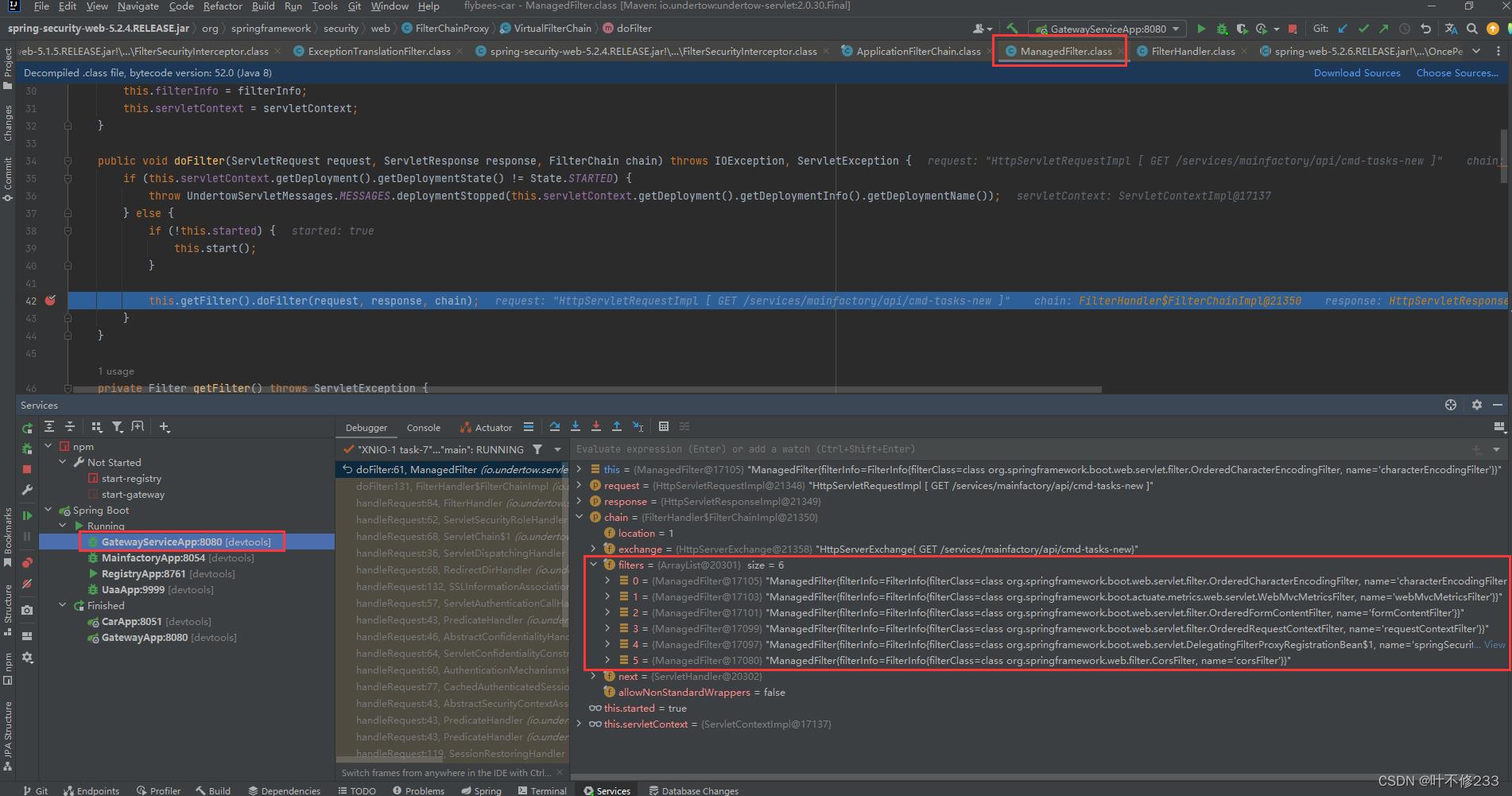SpringSecurity——OAuth2框架鉴权实现源码分析
Posted 叶不修233
tags:
篇首语:本文由小常识网(cha138.com)小编为大家整理,主要介绍了SpringSecurity——OAuth2框架鉴权实现源码分析相关的知识,希望对你有一定的参考价值。
SpringSecurity——OAuth2框架鉴权实现源码分析
一、ManagedFilter迭代过滤器链
ManagedFilter管理这六条过滤器链,如图所示:
其中的第五条过滤器链springSecurityFilterChain是本文要讨论的对象。
0.characterEncodingFilter
1.WebMvcMetricsFilter
2.formContentFilter
3.requestContextFilter
4.springSecurityFilterChain
5.corsFilter
ManagedFilter.class -> doFilter()
public void doFilter(ServletRequest request, ServletResponse response, FilterChain chain) throws IOException, ServletException
if (this.servletContext.getDeployment().getDeploymentState() != State.STARTED)
throw UndertowServletMessages.MESSAGES.deploymentStopped(this.servletContext.getDeployment().getDeploymentInfo().getDeploymentName());
else
if (!this.started)
this.start();
this.getFilter().doFilter(request, response, chain);//迭代下一条过滤器链

1.4 springSecurityFilterChain
在springSecurityFilterChain过滤器链中,首先初始化一个FilterChainProxy过滤器链代理对象,在这个过滤器链代理对象中有一个过滤器链集合,每一个过滤器链都有一组过滤器来处理不同的请求。
其中的第八条过滤器链OAuth2AuthenticationProcessingFilter是本文要讨论的对象,用于处理请求的鉴权。
FilterChainProxy.class --> doFilter()
public void doFilter(ServletRequest request, ServletResponse response) throws IOException, ServletException
if (this.currentPosition == this.size)
if (FilterChainProxy.logger.isDebugEnabled())
FilterChainProxy.logger.debug(UrlUtils.buildRequestUrl(this.firewalledRequest) + " reached end of additional filter chain; proceeding with original chain");
this.firewalledRequest.reset();
this.originalChain.doFilter(request, response);
else
++this.currentPosition;
Filter nextFilter = (Filter)this.additionalFilters.get(this.currentPosition - 1);//new了一个过滤器链代理对象
if (FilterChainProxy.logger.isDebugEnabled())
FilterChainProxy.logger.debug(UrlUtils.buildRequestUrl(this.firewalledRequest) + " at position " + this.currentPosition + " of " + this.size + " in additional filter chain; firing Filter: '" + nextFilter.getClass().getSimpleName() + "'");
nextFilter.doFilter(request, response, this); //迭代过滤器

1.4.7 OAuth2AuthenticationProcessingFilter
OAuth2鉴权主要用到了OAuth2AuthenticationProcessingFilter过滤器。这个过滤器下涉及到的类有以下12个类,大致作用是从请求中提取authentication,从authentication中获取token,判断是否为空,是否有效,是否过期。具体主要包含1-66个步骤的跳转和调用,详见代码中的注释。
【1】OAuth2AuthenticationProcessingFilter.class
这里是鉴权开始执行的起点,鉴权的大致步骤为以下内容:从请求中提取authentication --> 判断是否为空 --> 清除SpringSecurity上下文中的内容(如果有) --> 存到request的attributte中 --> 由authenticationManager进行鉴权操作 --> 将鉴权通过的事件进行广播 --> 将鉴权结果存储到SpringSecurity上下文中。
public void doFilter(ServletRequest req, ServletResponse res, FilterChain chain) throws IOException, ServletException
boolean debug = logger.isDebugEnabled();
HttpServletRequest request = (HttpServletRequest)req;
HttpServletResponse response = (HttpServletResponse)res;
try
//1.从请求中提取authentication,跳到【2】
Authentication authentication = this.tokenExtractor.extract(request);
//23.判断authentication是否为空,如果为空,也就是这个请求未携带token
if (authentication == null)
//24.如果this.stateless等于true,同时 SecurityContextHolder.getContext().getAuthentication()中的authentication不为空而且不属于匿名用户的authentication
if (this.stateless && this.isAuthenticated())
if (debug)
logger.debug("Clearing security context.");
SecurityContextHolder.clearContext();
if (debug)
logger.debug("No token in request, will continue chain.");
//25.如果请求中提取的authentication不为空
else
//26.把OAuth2AuthenticationDetails.ACCESS_TOKEN_VALUE作为key,authentication.getPrincipal()作为value存到request的attributte中
request.setAttribute(OAuth2AuthenticationDetails.ACCESS_TOKEN_VALUE, authentication.getPrincipal());
//27.判断authentication的对象是否是AbstractAuthenticationToken的实例
if (authentication instanceof AbstractAuthenticationToken)
//28.如果是,Authentication authentication向下转型为AbstractAuthenticationToken needsDetails
AbstractAuthenticationToken needsDetails = (AbstractAuthenticationToken)authentication;
//29.为needsDetails的details属性赋值,跳到【4】
needsDetails.setDetails(this.authenticationDetailsSource.buildDetails(request));
//31.跳到【5】,由authenticationManager进行鉴权后返回authResult,从【5】返回这里并开始下一行
Authentication authResult = this.authenticationManager.authenticate(authentication);
if (debug)
logger.debug("Authentication success: " + authResult);
//64.将鉴权通过的事件进行广播
this.eventPublisher.publishAuthenticationSuccess(authResult);
//65.将authResult存到SecurityContextHolder的context属性中
SecurityContextHolder.getContext().setAuthentication(authResult);
catch (OAuth2Exception var9)
SecurityContextHolder.clearContext();
if (debug)
logger.debug("Authentication request failed: " + var9);
this.eventPublisher.publishAuthenticationFailure(new BadCredentialsException(var9.getMessage(), var9), new PreAuthenticatedAuthenticationToken("access-token", "N/A"));
this.authenticationEntryPoint.commence(request, response, new InsufficientAuthenticationException(var9.getMessage(), var9));
return;
//66.放行
chain.doFilter(request, response);
private boolean isAuthenticated()
Authentication authentication = SecurityContextHolder.getContext().getAuthentication();
return authentication != null && !(authentication instanceof AnonymousAuthenticationToken);
【2】CookieTokenExtractor.class(我们自己重写的方法)
【2】~ 【3】这两个类里主要是从请求中获取authentication的具体实现步骤:大致上分为从SpringSecurity上下文中获取、从cookie中获取、从请求头中获取。从任意一个位置获取之后就把authentication返回到【1】。
@Override
public Authentication extract(HttpServletRequest request)
Authentication authentication = SecurityContextHolder.getContext().getAuthentication();
if (authentication != null) //2.从SecurityContextHolder中提取authentication
return authentication;//3.如果拿到了,直接返回提取到的authentication
//4.如果没拿到,调用父类extract(request)方法,跳到【3】
return super.extract(request);
//22.带着token跳到【1】
@Override
protected String extractToken(HttpServletRequest request)
String result;
//6.从cookie中提取authentication
Cookie accessTokenCookie = OAuth2CookieHelper.getAccessTokenCookie(request);
//7.如果拿到了,直接返回提取到的authentication
if (accessTokenCookie != null)
result = accessTokenCookie.getValue();
else
//8.如果没拿到,调用父类extractToken(request)方法,跳到【3】
result = super.extractToken(request);
//19.带着token,跳到C中的extract(HttpServletRequest request)
return result;
【3】BearerTokenExtractor.class -> extract()
public Authentication extract(HttpServletRequest request)
//5.调用子类中的extractToken(request),从请求中获取token
String tokenValue = this.extractToken(request);
//20.如果获取到了,包装token
if (tokenValue != null)
PreAuthenticatedAuthenticationToken authentication = new PreAuthenticatedAuthenticationToken(tokenValue, "");
//21.返回包装后的authentication,跳到【2】
return authentication;
else
return null;
protected String extractToken(HttpServletRequest request)
//9.调用本类中extractHeaderToken(request),从请求中获取token
String token = this.extractHeaderToken(request);
if (token == null)
logger.debug("Token not found in headers. Trying request parameters.");
token = request.getParameter("access_token");
if (token == null)
logger.debug("Token not found in request parameters. Not an OAuth2 request.");
else
request.setAttribute(OAuth2AuthenticationDetails.ACCESS_TOKEN_TYPE, "Bearer");
//18.带着token,跳到【2】
return token;
protected String extractHeaderToken(HttpServletRequest request)
//10.通过请求头的key【Authorization】获取对应的值
Enumeration<String> headers = request.getHeaders("Authorization");
String value;
do //11.遍历获取到的值
if (!headers.hasMoreElements())
return null;
value = (String)headers.nextElement();
//12.找到一个以"Bearer"开头的value,把这个value转换成全小写字母
while(!value.toLowerCase().startsWith("Bearer".toLowerCase()));
//13.把这个value前面的"Bearer"裁掉并且去空格处理,存储到authHeaderValue中
String authHeaderValue = value.substring("Bearer".length()).trim();
//14.把OAuth2AuthenticationDetails.ACCESS_TOKEN_TYPE作为key,"Bearer"作为value存到request的attributte中
request.setAttribute(OAuth2AuthenticationDetails.ACCESS_TOKEN_TYPE, value.substring(0, "Bearer".length()).trim());
//15.找到数字44在authHeaderValue中的下标
int commaIndex = authHeaderValue.indexOf(44);
if (commaIndex > 0)
//16.如果下标>0,也就是存在这个数字,就剪切开头到下标44所在的位置的值,重新赋给authHeaderValue
authHeaderValue = authHeaderValue.substring(0, commaIndex);
//17.否则直接返回authHeaderValue,跳到本类中的extractToken(HttpServletRequest request)
return authHeaderValue;
【4】OAuth2AuthenticationDetailsSource.class
这里创建了OAuth2AuthenticationDetails对象,把request存放进去
@Deprecated
public class OAuth2AuthenticationDetailsSource implements AuthenticationDetailsSource<HttpServletRequest, OAuth2AuthenticationDetails>
public OAuth2AuthenticationDetailsSource()
public OAuth2AuthenticationDetails buildDetails(HttpServletRequest context)
//30.new 了一个OAuth2AuthenticationDetails对象,把request存放进去,然后返回【1】
return new OAuth2AuthenticationDetails(context);
【5】OAuth2AuthenticationManager.class
这里是鉴权的核心处理器:从authentication中获取token后,解析token,并对解析后的token分别执行了是否为空判断、有效性和是否过期判断
public Authentication authenticate(Authentication authentication) throws AuthenticationException
//32.判断authentication是否为空,为空就抛异常
if (authentication == null)
throw new InvalidTokenException("Invalid token (token not found)");
else
//33.从authentication中获取token
String token = (String)authentication.getPrincipal();
//34.校验token的有效性和是否过期,跳到【6】
OAuth2Authentication auth = this.tokenServices.loadAuthentication(token);
if (auth == null)
throw new InvalidTokenException("Invalid token: " + token);
else
Collection<String> resourceIds = auth.getOAuth2Request().getResourceIds();
if (this.resourceId != null && resourceIds != null && !resourceIds.isEmpty() && !resourceIds.contains(this.resourceId))
throw new OAuth2AccessDeniedException("Invalid token does not contain resource id (" + this.resourceId + ")");
else
//61.调用本类中checkClientDetails(auth)方法
this.checkClientDetails(auth);
if (authentication.getDetails() instanceof OAuth2AuthenticationDetails)
OAuth2AuthenticationDetails details = (OAuth2AuthenticationDetails)authentication.getDetails();
if (!details.equals(auth.getDetails()))
details.setDecodedDetails(auth.getDetails());
auth.setDetails(authentication.getDetails());
auth.setAuthenticated(true);
//63.返回处理之后的auth,跳到【1】
return auth;
private void checkClientDetails(OAuth2Authentication auth)
//62.Oauth客户端如果为null ,不检查,如果配置了ClientDetailsService的实现类,会进行检查
if (this.clientDetailsService != null)
ClientDetails client;
try
//获取客户端
client = this.clientDetailsService.loadClientByClientId(auth.getOAuth2Request().getClientId());
catch (ClientRegistrationException var6)
throw new OAuth2AccessDeniedException("Invalid token contains invalid client id");
//获取客户端的授权范围
Set<String> allowed = client.getScope();
Iterator var4 = auth.getOAuth2Request().getScope().iterator();
//迭代授权范围,如果没有当前授权,就抛异常
while(var4.hasNext())
String scope = (String)var4.next();
if (!allowed.contains(scope))
throw new OAuth2AccessDeniedException("Invalid token contains disallowed scope (" + scope + ") for this client");
【6】DefaultTokenServices.class -> loadAuthentication(String accessTokenValue)
这里做两件事情:
1.是解析token,即把token解析为可以阅读的键值对
2.是对于token的为空判断、有效性和是否过期判断的具体步骤
public OAuth2Authentication loadAuthentication(String accessTokenValue) throws AuthenticationException, InvalidTokenException
//35.从解析token,跳到【7】
OAuth2AccessToken accessToken = this.tokenStore.readAccessToken(accessTokenValue);
//51.判断token是否为空,为空就抛异常
if (accessToken == null)
throw new InvalidTokenException("Invalid access token: " + accessTokenValue);
//53.判断token是否过期,过期就从tokenStore中移除token并且抛异常,跳到【11】
else if (accessToken.isExpired())
this.tokenStore.removeAccessToken(accessToken);
throw以上是关于SpringSecurity——OAuth2框架鉴权实现源码分析的主要内容,如果未能解决你的问题,请参考以下文章